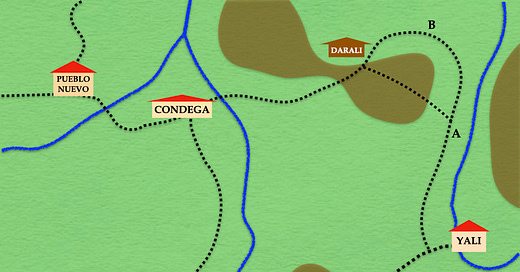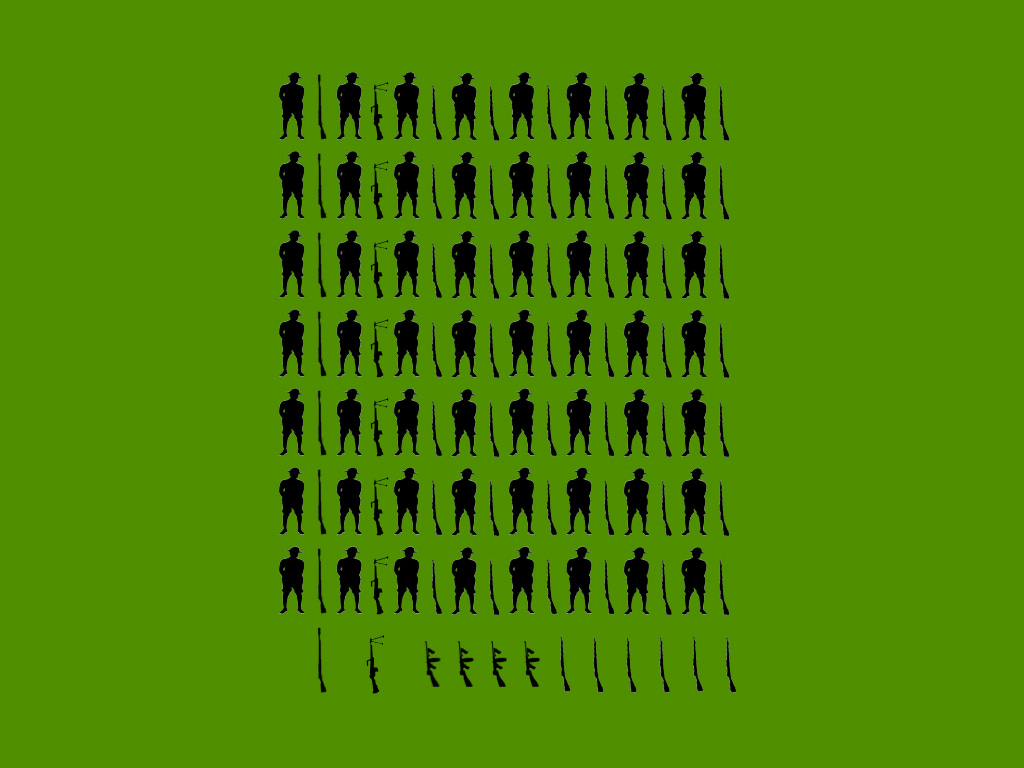Written by Lieutenant Harold D. Harris, USMC, this exercise appeared in Volume XI (January 1936) of the Infantry School Mailing List and Volume 21, Number 11 (November 1938) of The Leatherneck.
This is the fifth problem in the exercise. If you have not done so already, you will probably want to begin at the beginning.
DISCUSSION
The bandits had not yet reached the rear of the patrol, and as yet no Sandinistas were between the rear guard and the second squad. Therefore the gunnery sergeant could have promptly moved up and joined forces with the remainder of the patrol. This would have concentrated . the power of this small force and it could then better ward off an attack from any direction. But divided as it was it was liable to defeat in detail.
The mission of a rear guard is one of security and protection of the main body. By joining the remainder of the patrol, the rear guard would in this case be fulfilling its mission. Security of the entire group demanded concentration, and while moving up it could protect the patrol from any bandit force advancing from the east. In any event the patrol would, sooner or later, be surrounded, fighting faced in every direction of the compass. Which would be the "rear" then?
HISTORICAL SOLUTION
The gunnery sergeant replied to Sergeant “2d Squad" that he “had his orders” and was going to stay where he was. And stay he did for he did not get into the fight until the following afternoon.
Sergeant "2d Squad" on receiving the gunnery sergeant's reply, attempted to move his group to the rear and join the rear guard but was unsuccessful. The bandits, unaware of the presence of the rear squad, were now between the two groups of Marines.
Darkness was rapidly approaching and the forward group was now surrounded. A ring was formed, wounded men placed in the center and preparations made for defense. Shortly after dark the bandits rushed the position but the attack was beaten off by rapid rifle and automatic rifle fire. Twice more during the night the little band stayed off rushes. And over in the cornfield the lieutenant and corpsman spent a horrible night. Only by incessant and varied movement did they elude the force trying to locate them.
The messenger to the Condega outpost arrived there about 10:00 PM and when challenged answered "Marine." The captain in command of the outpost went out expecting to welcome the patrol, but was greeted instead with the information that the patrol had been ambushed, badly shot-up by a force of about 300, and needed immediate help. Only seven squads were stationed at Condega, but arms for an additional squad were kept there; also a few Thompson submachine guns.
The captain's first thought is to wire to battalion headquarters at Pueblo Nuevo for additional troops. But the telegraph line is dead in all directions. He tries the radio but that fails, too. He finally decides to move to the rescue of the patrol at once with four squads, leaving three squads at Condega.
REQUIREMENT
You are the captain. Would you make any readjustment of available weapons within your company before moving out?
Note: Each of your squads is armed with one Browning Automatic Rifle, one rifle fitted with a grenade-launcher cup, and six rifles. You also have four Thompson sub-machine guns.
The next step in this exercise is the presentation of the historical solution, which will be posted shortly. If you wish to reap full benefit from this decision-forcing case, please refrain from reading the historical solution until you have come to a decision.
Please feel free to use the comment section to describe your solution to this problem. In doing this, please refrain from posting any information that would spoil the problem for your fellow readers.







Bring all the heavier weapons - grenade-cup rifle, automatic rifle and SMGs - in preference to our rifles. We're trying to relieve a beleaguered friendly force which will require closing in to make contact, and if the enemy force really is as large as 300 we'll want to maximise our firepower to punch through our intended route and potentially appearing more substantial than we are.